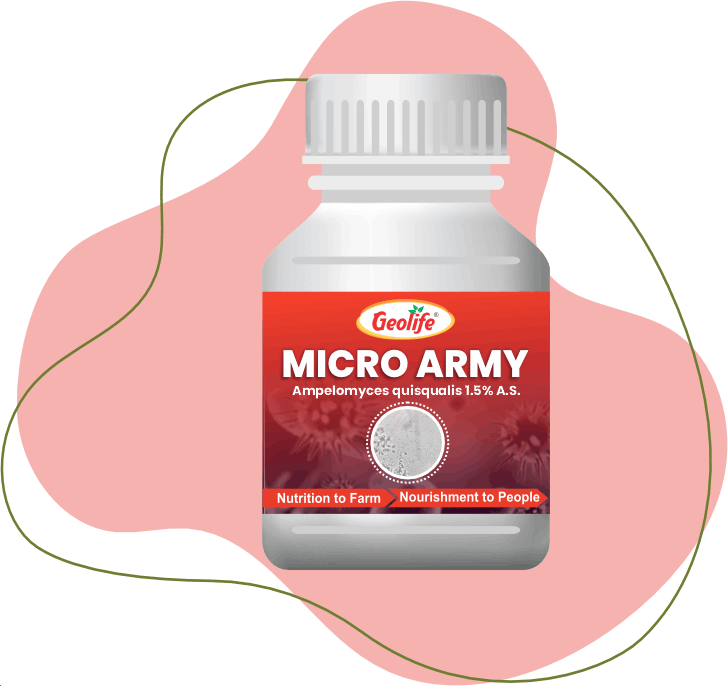
Broad-Spectrum Biopesticides for Effective Crop Protection
Broad-Spectrum Biopesticides for Effective Crop Protection

Broad-Spectrum Biopesticides for Effective Crop Protection
Mode of Action :
Hyperparasitism: Ampelomyces quisqualis acts as a hyperparasite, infecting powdery mildew pathogens.
Infection Process: It penetrates the powdery mildew structures, forming pycnidia within hyphae, conidiophores, and cleistothecia.
Nutritional Dependency: The fungus derives nutrition from the protoplasm of the infected mildew, multiplying within its body.
Colony Destruction: Eventually, it kills the mildew colony by consuming its resources.
Enzyme Production: Produces enzymes that dissolve the host’s cell walls, enabling penetration and inactivation of the host's defense mechanisms.
Benefits :
Eco-Friendly: Safe for the environment and easy to use.
Crop Health Improvement: Enhances crop health through the production of various hydrolytic enzymes.
Targeted Action: Effective against several powdery mildew species and various arthropod pests (e.g., insects, termites, thrips, whiteflies, aphids, beetles).
Increased Productivity: Contributes to higher crop yields.
Reduced Chemical Use: Decreases reliance on chemical pesticides, promoting sustainable agriculture.
| Crop | Application Method | Crop Stage |
|---|---|---|
| Rice | Foliar | Any Stage |
| Corn | Foliar | Any Stage |
| Wheat | Foliar | Any Stage |
| Crop | Application Method | Crop Stage |
|---|---|---|
| Chickpeas | Foliar | Any Stage |
| Pea | Foliar | Any Stage |
| Soybean | Foliar | Any Stage |
| Groundnut | Foliar | Any Stage |
| Crop | Application Method | Crop Stage |
|---|---|---|
| Cotton | Foliar | Any Stage |
| Sugarcane | Foliar | Any Stage |
| Tobacco | Foliar | Any Stage |
| Crop | Application Method | Crop Stage |
|---|---|---|
| Tomato | Foliar | Any Stage |
| Brinjal/ Eggplant | Foliar | Any Stage |
| Bell Pepper / Chilli | Foliar | Any Stage |
| Crop | Application Method | Crop Stage |
|---|---|---|
| Potato / Sweet Potato | Foliar | Any Stage |
| Cassava / Yams | Foliar | Any Stage |
| Ginger / Turmeric | Foliar | Any Stage |
| Crop | Application Method | Crop Stage |
|---|---|---|
| Spinach / Kale / Fenugreek / Amaranth / Celery / Coriander | Foliar | Any Stage |
| Lettuce / Cabbage / Cauliflower | Foliar | Any Stage |
| Crop | Application Method | Crop Stage |
|---|---|---|
| Rose / Jasmine | Foliar | Any Stage |
| Gladiolus / Gerbera | Foliar | Any Stage |
| Crop | Application Method | Crop Stage |
|---|---|---|
| Pineapple | Foliar | Any Stage |
| Banana | Foliar | Any Stage |
| Coconut / Arecanut | Foliar | Any Stage |
| Mango | Foliar | Any Stage |
| Oil palm / Dates | Foliar | Any Stage |
| Berries | Foliar | Any Stage |
| Citrus | Foliar | Any Stage |
| Grapes | Foliar | Any Stage |
| Pomegranate | Foliar | Any Stage |
| Jackfruit / Durian | Foliar | Any Stage |
| Papaya | Foliar | Any Stage |
| Crop | Application Method | Crop Stage |
|---|---|---|
| Lucerne / Berseem / Alfalfa / Napier / Para grass | Foliar | Any Stage |
| Crop | Application Method | Crop Stage |
|---|---|---|
| Spinach / Kale / Fenugreek / Amaranth / Celery / Coriander | Foliar | Any Stage |
| Lettuce / Cabbage / Cauliflower | Foliar | Any Stage |
250 gm per acre / 625 gm per hectare OR
500 ml per acre / 1.25 liters per hectare
Foliar or Soil Application